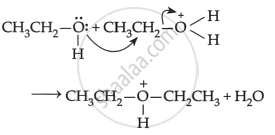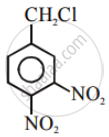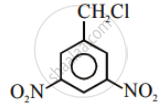Advertisements
Advertisements
प्रश्न
Give the mechanism of the following reaction:
\[\ce{CH3CH2OH ->[H2SO4][413 K] CH3CH2-O-CH2CH3 + H2O}\]
उत्तर
\[\ce{CH3CH2OH ->[H2SO4][413 K] \underset{Diethylether}{CH3CH2-O-CH2CH3} + H2O}\]
Mechanism: The formation of ether is a nucleophilic bimolecular reaction SN2 involving the attack of alcohol molecules on protonated alcohol as below:
(1) \[\ce{CH3CH2 - \underset{\bullet\bullet}{\overset{\bullet\bullet}{O}} - H + H+ -> CH3CH2 -^+ \underset{\bullet\bullet}{\overset{\ce{H}}{\overset{\bullet\bullet}{O}}} - H}\]
(2)

(3) \[\begin{array}{cc}
\ce{CH3CH2-\overset{+}{O}-CH2CH3 -> CH3CH2-O-CH2CH3 + H^+}\\
|\phantom{..................................}\\
\ce{H}\phantom{..................................}
\end{array}\]
\[\ce{H^+ + HSO^Θ_4 -> H2SO4}\]
APPEARS IN
संबंधित प्रश्न
How do you convert the following:
Ethanol to propanenitrile
Write the mechanism of the following reaction:
\[\ce{{n}BuBr + KCN ->[EtOH-H2O] {n}BuCN}\]
Out of C6H5CH2Cl and C6H5CHClC6H5, which is more easily hydrolysed by aqueous KOH.
AgCN reacts with haloalkanes to form isocyanide. Haloalkanes react with KCN to form alkyl cyanides as the main product. Why?
Isopropyl chloride undergoes hydrolysis by:
Identify the end product (C) in the following sequence:
\[\ce{C2H5OH ->[SOCl2][Pyridine] A ->[KCN {(alc.)}] B ->[2H2O/H^+] C}\]
The increasing order of nucleophilicity would be:
The decreasing order of reactivity of the following compounds towards nucleophilic substitution (SN2) is ______.
The following questions are case-based questions. Read the passage carefully and answer the questions that follow:
|
Nucleophilic Substitution: Influences of solvent polarity: The reaction rate (SN2) of 2-bromopropane and NaOH in ethanol containing 40% water is twice slower than in absolute ethanol. Hence the level of solvent polarity has an influence on both SN1 and SN2 reactions but with different results. Generally speaking, a weak polar solvent is favourable for SN2 reaction, while a strong polar solvent is favourable for SN1. Generally speaking, the substitution reaction of tertiary haloalkane is based on SN1 mechanism in solvents with a strong polarity (for example ethanol containing water). |
Answer the following questions:
(a) Why racemisation occurs in SN1? (1)
(b) Why is ethanol less polar than water? (1)
(c) Which one of, the following in each pair is more reactive towards SN2 reaction? (2)
(i) CH3 – CH2 – I or CH3CH2 – Cl
(ii)

OR
(c) Arrange the following in the increasing order of their reactivity towards SN1 reactions: (2)
(i) 2-Bromo-2-methylbutane, 1-Bromo-pentane, 2-Bromo-pentane
(ii) 1-Bromo-3-methylbutane, 2-Bromo-2-methylbutane, 2-Bromo-3- methylbutane
Explain why Grignard reagents should be prepared under anhydrous conditions.




